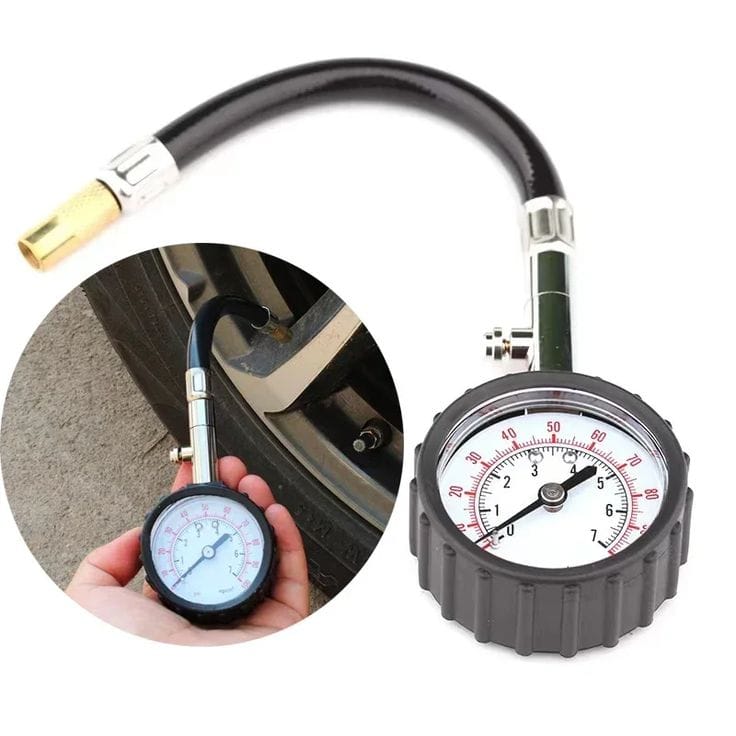How to Tell If My Tyre Pressure Is Too Low: A Complete Guide

Introduction
How to tell if my tyre pressure is too low? Maintaining correct tyre pressure affects safety, performance, and running costs. While modern vehicles often have TPMS (Tyre Pressure Monitoring Systems), knowing how to spot signs of worn tyres and pressure issues remains essential for all drivers. This guide covers all methods to identify underinflation and explains why prompt action matters.
Key Takeaways
- Visible sagging is the most obvious sign of underinflated tyres
- TPMS warning lights alert drivers to pressure drops (if equipped)
- Uneven tread wear develops faster with incorrect pressure
- Reduced fuel efficiency indicates potential inflation issues
- Handling changes like sluggish steering suggest low pressure
- Regular checks can prevent signs of worn tyres from developing prematurely
1. Visual Inspection Methods
Sidewall Bulge Check
- Properly inflated tyres show minimal sidewall curvature
- Underinflated tyres exhibit excessive bulge at the bottom
- Compare all four tyres for consistency
Tread Contact Test
- Place a coin in tread grooves across the width
- Uneven depth reveals pressure-related wear patterns
- Works best when tyres are cold
2. Vehicle Warning Systems
TPMS Alerts
- Dashboard warning light (yellow exclamation mark symbol)
- Some systems show individual tyre pressures
- May activate at 25% below recommended pressure
Limitations to Note
- Doesn’t replace manual checks
- May not detect slow leaks immediately
- Sensors can fail or need battery replacement
3. Driving Experience Indicators
Handling Changes
- Steering feels heavier or less responsive
- Vehicle leans more in corners
- Delayed braking response
Performance Symptoms
- Increased road noise
- Vibration through steering wheel
- Reduced fuel economy (up to 3% per 1 PSI drop)
4. Pressure Measurement Techniques
Digital Gauge Use
- Most accurate consumer method
- Check when tyres are cold (not driven in 3+ hours)
- Compare to manufacturer’s recommended PSI
Service Station Gauges
- Variable accuracy between stations
- Best for quick checks between proper measurements
- Avoid relying exclusively on these
5. Consequences of Persistent Underinflation
Safety Risks
- Longer braking distances
- Increased aquaplaning risk
- Potential blowouts from overheating
Cost Impacts
- Up to 15% faster tread wear
- 2-3mpg fuel economy reduction
- Suspension component stress
6. Recommended Checking Routine
| Frequency | Action | Notes |
| Monthly | Manual pressure check | Use quality gauge |
| Before long trips | Visual + pressure inspection | Adjust for load |
| After temperature drops | Recheck pressures | 1°C change = 0.1 PSI change |
| When carrying heavy loads | Increase pressure as specified | Check door jamb sticker |
FAQs: Low Tyre Pressure Explained
How much pressure loss is dangerous?
Any pressure below the manufacturer’s recommended level affects performance. More than 5 PSI under requires immediate attention.
Can I tell pressure just by kicking the tyre?
No. Modern radial tyres often feel firm even when significantly underinflated. Always use a proper gauge.
Why do tyres lose pressure over time?
Natural air permeation causes about 1-2 PSI loss monthly. Temperature changes account for another 1 PSI per 10°C shift.
Does low pressure always cause visible sagging?
Not until severely underinflated (typically below 50% of recommended pressure). Earlier detection requires measurement.
Professional Support and Next Steps
While regular DIY checks help maintain proper inflation, professional inspections at Tyrevortex can identify slow leaks, valve issues, or other problems causing pressure loss. Their technicians can:
- Perform leak detection tests
- Check for rim seal issues
- Advise on load-specific pressures
- Inspect for signs of worn tyres related to inflation problems
Remember: Correct tyre pressure is the simplest maintenance task with the biggest impact on safety and costs. Make monthly checks part of your routine and address pressure warnings promptly. For comprehensive tyre services and expert advice, visit Tyrevortex to ensure your vehicle remains in optimal condition.